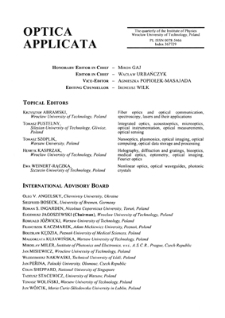Lower Silesian Digital Library contains 109 387 digital objects
Object
Title: AFM examination of sol–gel matrices doped with photosensitizers
Creator:
Wysocka, Katarzyna ; Ulatowska-Jarża, Agnieszka ; Bauer, Joanna ; Hołowacz, Iwona ; Savu, Bogdan ; Stanciu, George ; Podbielska, Halina
Contributor:
Gaj, Miron. Redakcja ; Urbańczyk, Wacław. Redakcja
Description:
Optica Applicata, Vol. 38, 2008, nr 1, s. 127-136
Abstrakt:
Publisher:
Oficyna Wydawnicza Politechniki Wrocławskiej
Place of publication:
Date:
Resource Type:
Resource Identifier:
Source:
<sygn. PWr A3481II> ; click here to follow the link ; click here to follow the link
Language:
Relation:
Optica Applicata ; Optica Applicata, Vol. 38, 2008 ; Optica Applicata, Vol. 38, 2008, nr 1 ; Politechnika Wrocławska. Wydział Podstawowych Problemów Techniki
Rights:
Wszystkie prawa zastrzeżone (Copyright)
Access Rights:
Dla wszystkich w zakresie dozwolonego użytku
Location:
Group publication title:
Object collections:
- Lower Silesian Digital Library > Participants of the Consortium > 01. Wrocław University of Science and Technology > Journals WUoT > Journals published at Wrocław University of Technology > Optica Applicata
- Lower Silesian Digital Library > Resources > 2. Czasopisma > Czasopisma współczesne
- Lower Silesian Digital Library > Fields of science > 6. Nauki ścisłe i przyrodnicze
Last modified:
Mar 21, 2019
In our library since:
Mar 21, 2019
Number of object content hits:
92
All available object's versions:
https://www.dbc.wroc.pl/publication/113959
Show description in RDF format:
Show description in OAI-PMH format:
| Edition name | Date |
|---|---|
| AFM examination of sol–gel matrices doped with photosensitizers | Mar 21, 2019 |
Objects Similar
Hołowacz, Iwona Ulatowska-Jarża, Agnieszka Wysocka, Katarzyna Głuchowski, Paweł Stręk, Wiesław Podbielska, Halina Gaj, Miron. Redakcja Urbańczyk, Wacław. Redakcja
Hołowacz, Iwona Podbielska, Halina Bauer, Joanna Ulatowska-Jarża, Agnieszka Gaj, Miron. Redakcja Wilk, Ireneusz. Redakcja
Ulatowska-Jarża, Agnieszka Hołowacz, Iwona Wysocka, Katarzyna Podbielska, Halina Gaj, Miron. Redakcja Urbańczyk, Wacław. Redakcja
Ulatowska-Jarża, Agnieszka Podbielska, Halina Gaj, Miron. Redakcja Wilk, Ireneusz. Redakcja
Andrzejewski, Damian Podbielska, Halina Ulatowska-Jarża, Agnieszka Gaj, Kazimierz. Redakcja Wilk, Ireneusz. Redakcja
Jeleń, Łukasz Cegielski, Marek Ulatowska-Jarża, Agnieszka Podbielska, Halina Gaj, Miron. Redakcja Wilk, Ireneusz. Redakcja
Ulatowska-Jarża, Agnieszka Lechna-Marczyńska, Monika Podbielska, Halina Gaj, Kazimierz. Redakcja Wilk, Ireneusz. Redakcja
Bauer, Joanna Ulatowska-Jarża, Agnieszka Podbielska, Halina Lechna-Marczyńska, Monika Bindig, Uwe Müller, Gerhard Beuthan, Jürgen Gaj, Miron. Redakcja Wilk, Ireneusz. Redakcja
























